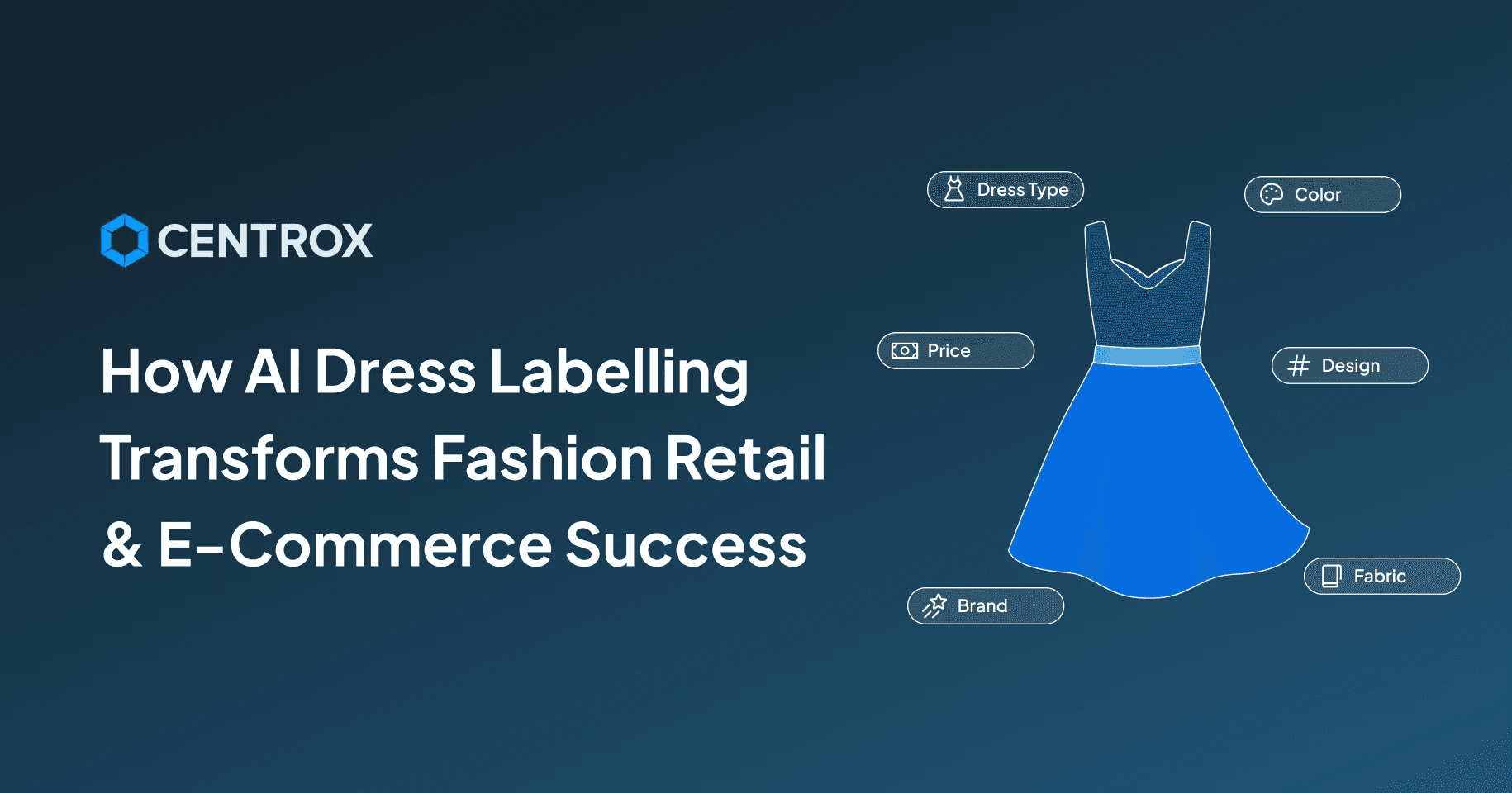How AI Dress Labeling Transforms Fashion Retail & E-Commerce Success?
Discover how the AI dress labeling tool transforms fashion and retail by solving key challenges, boosting accuracy, and efficiency.
9/15/2025
artificial intelligence
10 mins

Evolving fashion trends and growing customer demands have created a need for automating the fashion, retail, and e-commerce industries. In today's busy world, customers no longer have an extensive buying journey. Here, having AI-driven integration can help you give an edge over your competitors. So an AI dress labeling tool has the potential to be that solution that enhances the buying journey by making it convenient, personalized, and fast.
An AI dress labeling tool can be integrated into your fashion, retail, and e-commerce brand to enhance customer experience. Ensuring automated tagging can help in search discovery, personalized recommendation, inventory management, data analysis, and even in enhancing security surveillance in your outlet.
In our blog, we will help you explore how AI dress labeling works, its use cases for businesses, its benefits, and some challenges. So that you are well aware of this solution, and confident about deciding to integrate it into your fashion or e-commerce business.
Problems Without an AI Dress Labeling Tool
The conventional fashion, retail, and e-commerce processes hold a lot of gaps. Each gap can lead to missed opportunities and ultimately limit your business from reaching its potential revenue and profits. Below, we mentioned a few problems that these fashion, retail, and e-commerce businesses experience every day because of the absence of an AI dress labeling solution:
- Slow Manual Cataloging: Manual product tagging consumes a lot of time and effort, delaying the process and making it highly inefficient, especially for handling large volumes.
- Inconsistent Labeling: Many people use different terms for labeling the same item, which creates inconsistency and eventually confuses customers, disrupting their buying journey.
- Poor Search & Discovery: The inconsistent labeling sometimes leads customers to struggle to find specific items due to missing or vague product attributes.
- Weak Personalization & Recommendations: These incomplete labels significantly impact in contribution of inaccurate suggestions for similar or complementary products, affecting the buying experience.
- High Return Rates: Many businesses have to face high product return rates because of providing unclear or incorrect product descriptions that do not match customer expectations.
- Inefficient Inventory Management: A lot of retailers face difficulties in categorizing, organizing, and tracking stock, making this routine task time and effort-intensive.
- Missed Trend Analysis: Because of not having proper and accurate tagging, brands often fail to identify which colors, styles, or patterns are gaining popularity, limiting them to understand customer preferences.
- Reduced Cross-Selling Opportunities: the absence of such systems restricts the retailers from recommending matching items (e.g., shoes, bags, accessories), leading to a missed opportunity.
- Delayed Market Response: The absence of such an AI labeling tool creates a void between Retailers and brands, which makes them slow in reacting to emerging trends due to reliance on manual recognition.
What is AI Dress Labeling?
AI dress labeling is an automated approach for identifying, classifying, and labeling clothes as per their properties like color, style, fabric, pattern, seasons, and occasions using computer vision and machine learning algorithms. Such AI tools enhance customer experience by enhancing search results, personalization, inventory management, and trend analysis across fashion and retail.
How does AI Dress Labeling Work?
AI dress labeling solution delivers these intelligent results because of the algorithm and methodology that work behind it. This procedure looks after the entire cycle automatically, to help businesses in executing their everyday tasks. Below, we have provided the step-wise breakdown of how the AI dress labeling tool works:
Step 1: Data Collection
The initial step in the process of AI dress labeling is data collection. This is done by collecting the visual data from various sources, or uploads, to build a broad dataset, which represents diverse styles, lighting conditions, and cultural fashion variations.
Step 2: Annotation
Once the data collection is done, the next step is to assign a label to each garment feature found in the image, which could be type, color, fabric, style, or pattern. This creates the ground-truth dataset that trains the AI to recognize clothing characteristics accurately.
Step 3: Preprocessing
Then, under the preprocessing step, the labeled data set is cleaned, resized, and augmented through cropping, flipping, or adjusting brightness. This helps ensure that the model becomes robust and performs consistently under different real-time conditions and environments.
Step 4: Model Training
Once the data preparation is complete, it's time for training deep learning models, often using transfer learning. This helps in detecting garments and further classifying their attributes, to refine accuracy through hyperparameter tuning and validation checks.
Step 5: Inference
When a new image is provided by the user as input, the trained model identifies the garments, classifies their attributes, and intelligently assigns accurate descriptive labels within seconds.
Step 6: Integration
Then the labeled data is stored in the databases, allowing the tool to perform tasks like product search, visual discovery, personalization, recommendations, and smarter inventory or trend analysis.
Step 7: Feedback & Improvement
In the last step, the AI dress labeling tool monitors predictions, tracks user corrections, and re-trains the system regularly with the new data to continuously improve performance over evolving trends and reduce the chances of errors.
Use cases of AI Dress Labeling
AI dress labeling has diverse use cases to enhance your business performance. By integrating it into your business operations, smarter alternative for various tasks like tagging, search, and recommendation. This makes busying easy and results in more conversions. Here are key use cases of AI dress labeling:
1. Automated Product Tagging
- An AI dress labeling tool can instantly generate detailed tags (e.g., “red floral maxi dress, cotton, sleeveless”), reducing manual effort, speeding up catalog management, and ensuring consistent product descriptions across fashion platforms.
- Industry Application: Zalando - Ensures consistent catalog metadata.
2. Visual Search & Discovery
- With the availability AI dress labeling tool, shoppers can upload a photo or screenshot, and the AI will help find visually similar dresses, improving product discovery, boosting engagement, and making the shopping experience convenient, fast, and seamless.
- Industry Application: ASOS - Finds similar outfits instantly.
3. Personalized Recommendations
- This AI dress labeling tool can understand clothing attributes and suggest complementary outfits or accessories (e.g., shoes for a dress), enhancing cross-selling opportunities and providing tailored shopping journeys.
- Industry Application: H&M - Suggests tailored outfit pairings.
4. Trend & Demand Analysis
- Through this AI tool, fashion brands, retailers, and e-commerce business platforms can analyze which colors, fabrics, or styles are trending across platforms and regions, helping brands forecast demand, design better collections, and respond faster to market shifts.
- Industry Application: Stitch Fix - Predicts upcoming style trends.
5. Inventory & Retail Management
- Retailers can use AI labels to organize stock efficiently, reduce search errors, and simplify inventory tracking. This helps in restocking the required clothing product efficiently and ensures products are easily found online and in-store.
- Industry Application: Myntra - Optimizes stock and restocking.
6. Accessibility Support
- For visually impaired users, AI describes clothing attributes aloud, enabling independent shopping and outfit planning while improving inclusivity in fashion, retail, and e-commerce platforms, while providing you a competitive edge.
- Industry Application: Tommy Hilfiger - Enables inclusive fashion access.
Benefits of AI Dress Labeling
AI dress labeling is revolutionizing fashion, retail, and e-commerce by automating product tagging and enhancing customer experiences. It improves search, personalization, inventory, and trend forecasting while reducing costs, returns, and accessibility gaps. Here are its key benefits.
1. Saves Time and Cost
An AI dress labeling tool can automate product tagging and descriptions, significantly reducing manual effort, minimizing operational costs, speeding up catalog updates, and enabling businesses to focus on innovation and customer engagement.
2. Improves Search & Discovery
With its detailed, consistent AI-generated labels, it makes product discovery easier to find through filters, keywords, and visual search. This ensures convenient shopping experiences and results in higher conversions for online retailers.
3. Enhances Personalization
By analyzing attributes, this AI-enabled tool can recommend similar styles, matching outfits, or seasonal trends, enhancing customer satisfaction, loyalty, and encouraging repeat purchases with more personalized shopping experiences.
4. Reduces Return Rates
Accurate AI-driven dress labeling helps in preventing mismatches between descriptions and delivered products. This ensures customers get the right product, lowering return rates, saving costs, and improving overall trust in fashion brands.
5. Strengthens Inventory Management
AI-driven tags contribute to streamlining categorization and efficient tracking of stock across platforms. It reduces the chances of error occurrence, avoiding stockouts or overstocking, and ensuring accurate, efficient inventory management for retailers and e-commerce platforms.
6. Supports Trend Forecasting
An AI tool can identify popular styles, fabrics, or colors from massive data, assisting fashion businesses to predict demand, adapt collections quickly, and stay competitive in fast-evolving markets.
7. Boosts Accessibility
AI labels provide descriptive product details for visually impaired shoppers, supporting independent browsing and purchasing while making fashion platforms more inclusive and socially responsible.
Limitations of AI Dress Labeling
While AI dress labeling makes different operations fast and convenient, it also has some limitations. Therefore, it's really important for businesses to understand these limitations so that they can strategize their solution accordingly. Below are some limitations of AI dress labeling:
1. Data Quality & Diversity
Incomplete, biased, or low-quality datasets can reduce AI accuracy in recognizing fabrics, styles, and cultural variations, ultimately compromising user experience and trust in the platform.
2. Evolving Fashion Trends
The fashion trends evolve rapidly, which introduces shifting in styles, demand, and preferences, which might need frequent retraining and model updates to provide the right trends.
3. Complexity of Fabrics & Styles
Multi-layered outfits, intricate patterns, and niche designs complicate accurate labeling, which could be difficult for the algorithm to identify and eventually categorize.
4. Integration with Existing Systems
Technical hurdles may arise when syncing AI tools with current e-commerce platforms; this might require technical expertise to ensure smooth deployments and integrations with the existing environment.
5. Cost & Scalability
Initial implementation, model training, and scaling require significant investment and resources, so it's very important to discuss and plan them before implementing them.
Why should your Business adopt AI Dress Labeling?
AI dress labeling is redefining the future of fashion, retail, and e-commerce businesses. These smart innovations are addressing critical challenges like inconsistent product descriptions, poor searchability, high return rates, and inefficient inventory management.
Automating tagging and delivering accurate product attributes makes shopping journeys smoother, with stronger personalization and sharper trend forecasting. Thus, integrating this technology into existing workflows can not only reduce costs but also streamline various operations and unlock new growth opportunities.
If a fashion, retail, or e-commerce business wants to stay ahead of its competitors, the smarter way forward is to begin with small-scale AI labeling pilots, and then measure gains in search accuracy, returns, and sales, to further expand adoption in building an autonomy in the fast-changing fashion landscape.
What could your business achieve if every product were instantly and accurately labeled by AI? Discuss with our experts at Centrox AI by booking your first free session with us, and redefine the future of your business.

Muhammad Haris Bin Naeem
Muhammad Harris Bin Naeem, CEO and Co-Founder of Centrox AI, is a visionary in AI and ML. With over 30+ scalable solutions he combines technical expertise and user-centric design to deliver impactful, innovative AI-driven advancements.
Do you have an AI idea? Let's Discover the Possibilities Together. From Idea to Innovation; Bring Your AI solution to Life with Us!
Your AI Dream, Our Mission
Partner with Us to Bridge the Gap Between Innovation and Reality.
